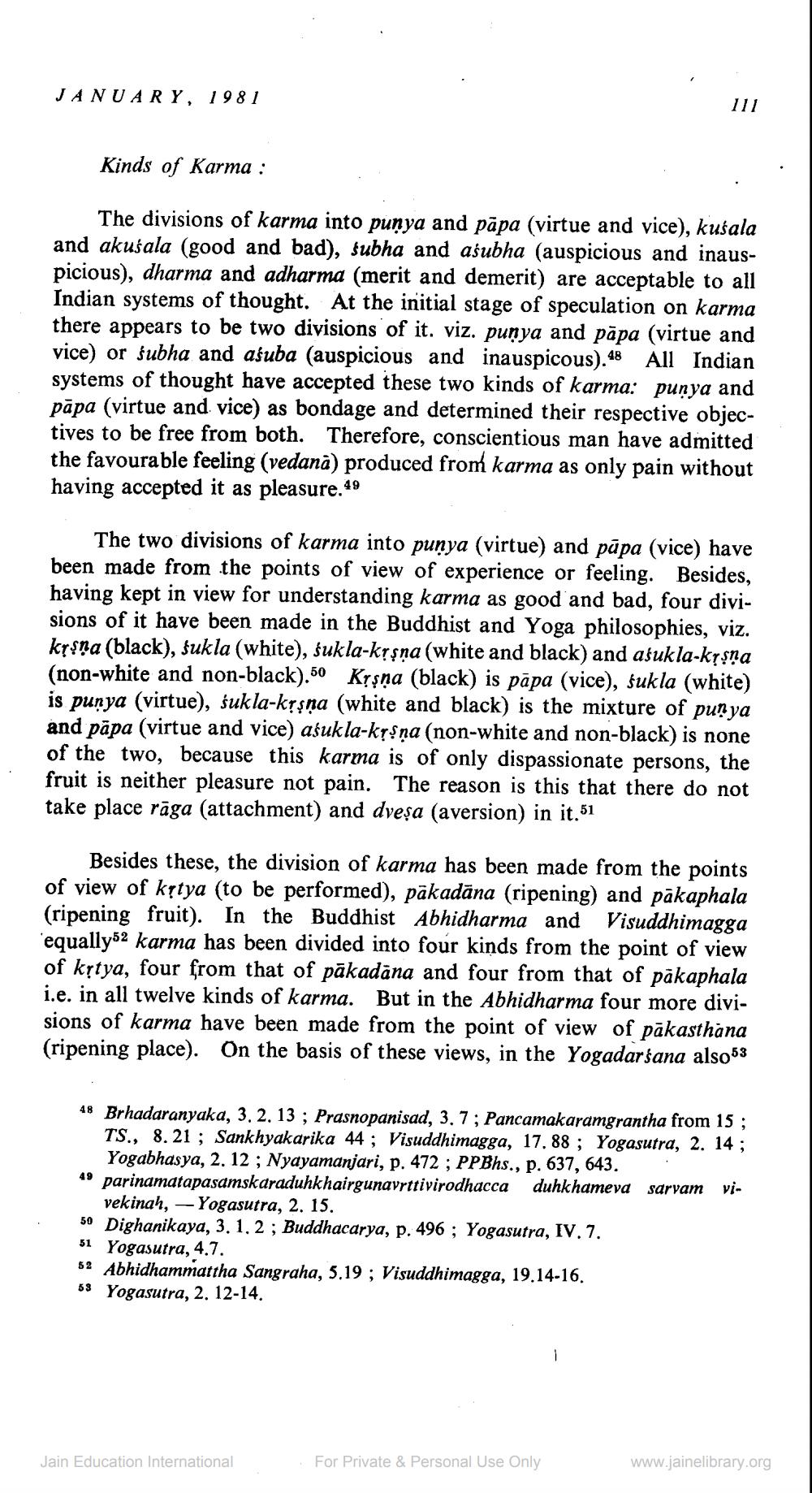________________
JANUARY, 1981
Kinds of Karma :
The divisions of karma into punya and pāpa (virtue and vice), kušala and akušala (good and bad), subha and aśubha (auspicious and inauspicious), dharma and adharma (merit and demerit) are acceptable to all Indian systems of thought. At the initial stage of speculation on karma there appears to be two divisions of it. viz. punya and pāpa (virtue and vice) or śubha and asuba (auspicious and inauspicous).48 All Indian systems of thought have accepted these two kinds of karma: punya and pāpa (virtue and vice) as bondage and determined their respective objectives to be free from both. Therefore, conscientious man have admitted the favourable feeling (vedana) produced from karma as only pain without having accepted it as pleasure. 49
The two divisions of karma into punya (virtue) and pūpa (vice) have been made from the points of view of experience or feeling. Besides, having kept in view for understanding karma as good and bad, four divisions of it have been made in the Buddhist and Yoga philosophies, viz. kršņa (black), fukla (white), sukla-krsna (white and black) and aśukla-kȚsna (non-white and non-black).50 Krşņa (black) is pāpa (vice), sukla (white) is punya (virtue), śukla-kışņa (white and black) is the mixture of punya and pāpa (virtue and vice) aśukla-krsna (non-white and non-black) is none of the two, because this karma is of only dispassionate persons, the fruit is neither pleasure not pain. The reason is this that there do not take place rāga (attachment) and dveșa (aversion) in it.51
Besides these, the division of karma has been made from the points of view of krtya (to be performed), pākadāna (ripening) and pākaphala (ripening fruit). In the Buddhist Abhidharma and Visuddhimagga equally52 karma has been divided into four kinds from the point of view of krtya, four from that of pākadana and four from that of päkaphala i.e. in all twelve kinds of karma. But in the Abhidharma four more divisions of karma have been made from the point of view of pākasthana (ripening place). On the basis of these views, in the Yogadarśana also53
48 Brhadaranyaka, 3. 2. 13; Prasnopanisad, 3.7; Pancamakaramgrantha from 15 ;
TS., 8.21 ; Sankhyakarika 44 ; Visuddhimagga, 17.88 ; Yogasutra, 2. 14 ;
Yogabhasya, 2. 12 ; Nyayamanjari, p. 472 ; PPBhs., p. 637, 643. . 49 parinamatapasamskaraduhkhairgunavrttivirodhacca duhkhameva sarvam vi
vekinah, -Yogasutra, 2. 15. 50 Dighanikaya, 3.1.2 ; Buddhacarya, p. 496 ; Yogasutra, IV. 7. 51 Yogasutra, 4.7. 52 Abhidhammattha Sangraha, 3.19 ; Visuddhimagga, 19.14-16. 58 Yogasutra, 2. 12-14.
For Private & Personal Use Only
www.jainelibrary.org
Jain Education International




